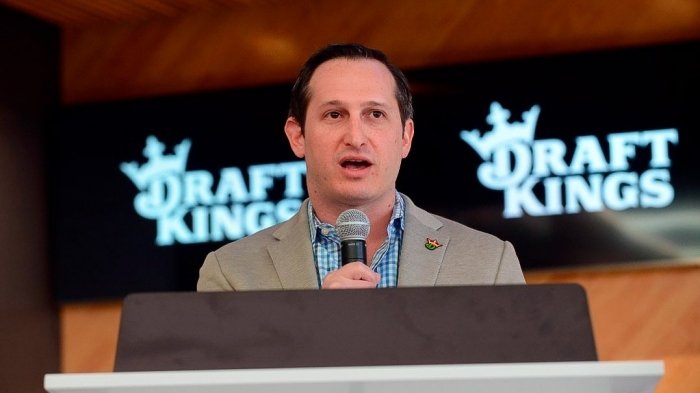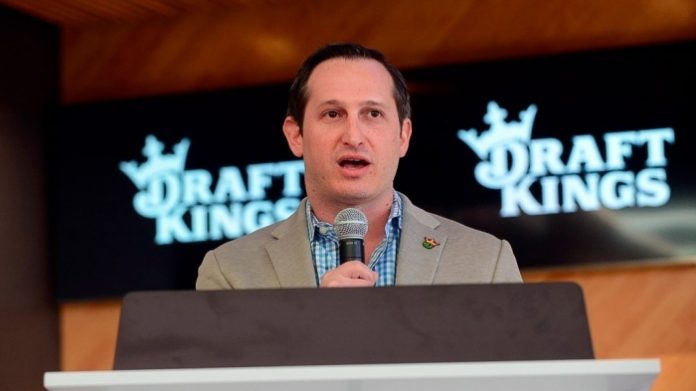
I
n an interview with Fox Business, DraftKings CEO Jason Robins discussed the business of sports betting, local and federal regulations, and the future of his company.
“Many new states adopting legislation and regulatory frameworks” as it pertains to sports betting activity, would take DraftKings from “high growth to hyper growth,” Robins told “Mornings with Maria” on Thursday.
Robins also noted that the company is “expecting 40-plus-percent growth even in the absence of any new states launching next year.”
Last month, the Boston-based sports-betting app reported a significant increase in users for the third quarter.
The company’s business-to-consumer surged by 64% compared to the third quarter of 2019, according to the company, which noted that “on average, more than a million monthly unique paying customers engaged with DraftKings each month during the third quarter.”
The company reported revenue of $133 million, an increase of 98% compared to $67 million during the same period in 2019. Analysts surveyed by Refinitiv were expecting $132 million.
DraftKings also raised its fiscal year 2020 guidance to a range of $540 million to $560 million, from a range of $500 million to $540 million. It also introduced 2021 revenue guidance of $750 million to $850 million, “which equates to 45% year-over-year growth,” according to the company.
DraftKings reported a third-quarter loss of $348 million, or an adjusted 57 cents per share, beating analysts’ expectations.
In November, Robins told investors that he had attributed the growth in the third quarter in part to “the resumption of major sports such as the NBA, MLB and the NHL in the third quarter, as well as the start of the NFL season” following a pause during the coronavirus pandemic, which “generated tremendous customer engagement.”
DraftKings experienced a significant loss in the three months through June as the coronavirus pandemic put most sports on hold, which limited betting.
The company posted a second-quarter loss of $161.4 million, or 55 cents per share, as revenue jumped 24% from a year ago to $70.9 million. Wall Street analysts surveyed by Refinitiv were expecting an adjusted loss of 19 cents per share on revenue of $66.4 million.
Host Maria Bartiromo asked Robins where he sees the growth in sports betting coming from in the next three years.
“First and foremost is what hopefully will be many new states adopting legislation and regulatory frameworks to bring this activity into a legal, safe environment,” he responded.
“Just this year, we’ve launched in three new states for online sports betting, four if you count New Hampshire, although that was technically December 30 of last year, and we also have launched two new states for iCasino for iGaming so we’re hopeful that more states will take action next year and we’ll see even more of the population able to access DraftKings sports betting product.”
New York may be the next state to legalize online sports betting and is reportedly close, according to a PlayNY article, which cited New York Assemblyman Gary Pretlow who reportedly told the outlet that he had solidified a commitment from Assembly Speaker Carl Heastie to include mobile sports betting in a revenue bill.
Bartiromo referenced the fact that the stock is up more than 350% year-to-date and noted that “the bulls are pointing to the strong revenue as a guide.” She also noted that there are “skeptics talking about the declining gross margins,” cash burn and “modest sequential wager growth.”
Bartiromo then asked Robins, “Is there a plan B to ensure that you can in fact see that growth takes place, regardless of what’s happening in the regulatory framework?”
“Absolutely, I mean the state that we’ve been operating in the longest, New Jersey, this is our third NFL season, is still growing triple digits year-over-year for us so it’s by no means slowing down even in the states that have launched,” he responded.
“And even on the basis of the states that we’ve already launched, we already told Wall Street that we expect to do higher revenue next year than we previously thought and expect substantial growth so I think any additional states really take it from high growth to hyper growth, but we’re expecting 40-plus percent growth even in the absence of any new states launching next year.”














